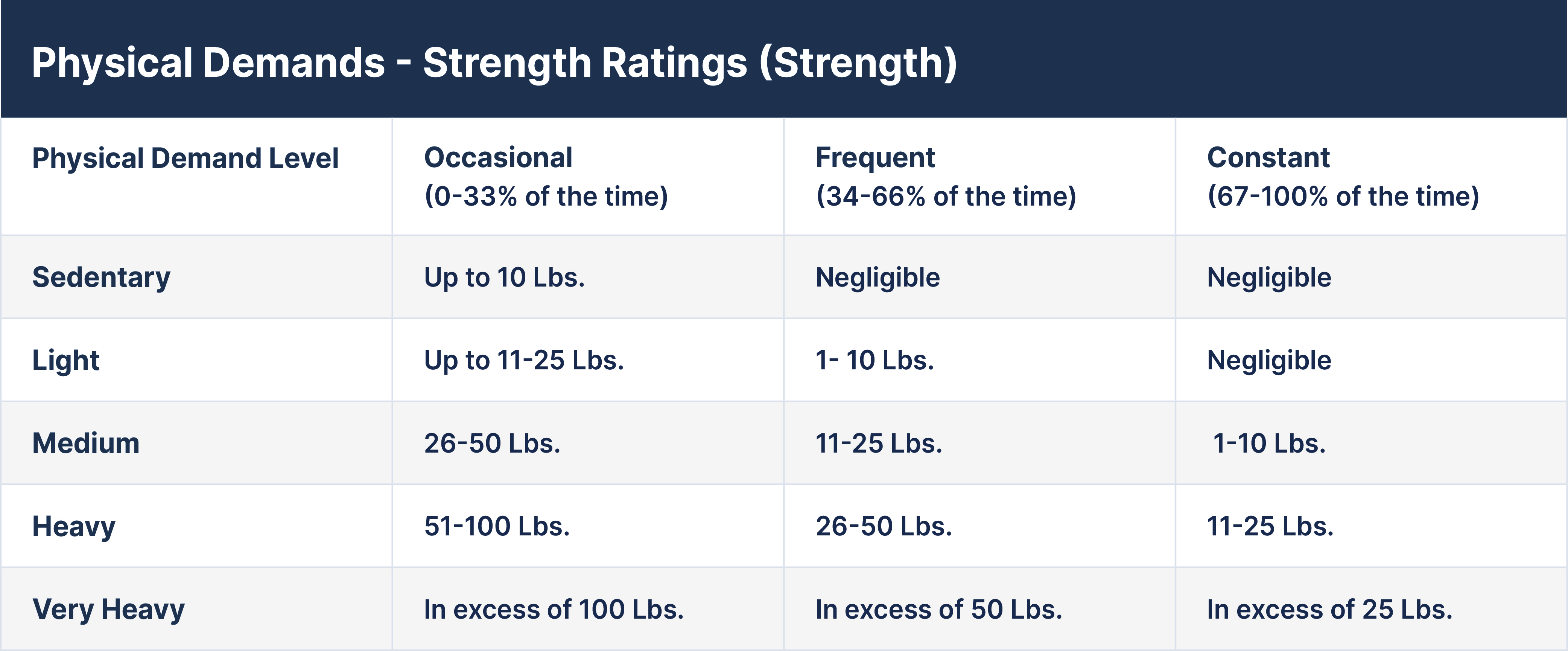The Physical Demand Level (PDL) is a crucial component of any Functional Capacity Evaluation, so it’s important that you understand how to accurately interpret how the PDL is determined in Functional Capacity Evaluations.
In 2024, the Bureau of Labor Statistics defined 5 categories of physical demand based on bilateral material handling activities (lift, carry, push/pull), sitting, standing, walking, and exertion required throughout a workday.

The physical demand level is an important component of an FCE for the following reasons:
-
1. Objective Comparison to Client’s Job Demands:
This information correlates to the maximum strength capabilities of a client and compares to the strength requirements of a job to identify whether that client can safely return to work.
-
2. Supports Return-to-Work Decisions:
Can the client’s capabilities meet the job’s physical demands? This is important as it can prevent re-injury and will ensure sustainable employment.
-
3. Legal and Insurance Decisions:
PDL ratings are used by attorneys and insurance adjusters in making decisions with disability and workers' compensation claims.
-
4. Rehabilitation Recommendations:
PDL information is used to design specific rehab programs, such as work hardening/work conditioning programs or onsite rehab programs.
-
5. Vocational Assessment:
The PDL information in an FCE facilitates vocational professionals to identify transferable work skills and identify suitable job opportunities within a client’s physical capabilities.
-
6. Risk Management:
Employers utilize PDL information from an FCE to reduce workplace injury and minimize risk by ensuring the job demands align with the employee’s physical capacity.
Evaluating Physical Demand Levels in Functional Capacity Evaluations:
While Physical Demand Levels primarily focus on material handling (strength requirements), a client’s ability to sit, stand, and walk is equally important when determining work capacity. According to the Employee Retirement Income Security Act (ERISA) Disability guidelines:
-
Sitting:
To perform the full range of sedentary work, an individual must be able to sit for about 6 hours during an 8-hour workday, typically in 2-hour intervals with standard breaks. If a person cannot sit for a total of 6 hours, the unskilled sedentary occupational base is considered eroded.
-
Standing and Walking:
Sedentary work also requires standing and walking for about 2 hours in total per 8-hour day. If a person is limited to standing or walking only briefly, this further erodes the occupational base.
When identifying the most accurate PDL in a Functional Capacity Evaluation, it’s essential to consider the full picture, including all demonstrated material handling abilities, as well as sitting, standing, and walking tolerances.
Determining PDL Using Software
The OccuPro Software typically assigns a Physical Demand Level (PDL) based on the lowest occasional material handling task a client can perform. If a client’s lowest occasional lift is 0 lbs. from floor to waist, the PDL is calculated as Sedentary. If the client can also sit frequently, as required for sedentary work, then they fall within the full range of sedentary capacity.

(Click here to enlarge)
Client demonstrated the ability to perform within the SEDENTARY Physical Demand Category based on the 2024 strength level definitions developed by the Bureau of Labor Statistics, which is below her job's demand category. Based on sitting and standing abilities, this client may be able to work full-time within the SEDENTARY physical demand category, which is below her job's demand category, for up to 8 hours per day while taking into account her need to alternate sitting and standing. It should be noted that the client's job as a construction worker is classified within the HEAVY Physical Demand Category.
Exception: PDL Not Based on Lowest Occasional Material Handling
In some cases, the PDL is not based on the lowest occasional material handling task. For example, if a client can stand and walk frequently, this expands their physical capacity. In this case, the client’s Physical Demand Level was set at Light, based on their ability to perform an occasional bilateral carry, despite having a lower occasional lift elsewhere. Their frequent standing and walking supported a higher overall PDL.

(Click here to enlarge)
The client demonstrated the ability to perform within the LIGHT Physical Demand Category based on the 2024 strength level definitions developed by the Bureau of Labor Statistics, which is below her job's demand category. Based on sitting and standing abilities, this client may be able to work full-time within the LIGHT physical demand category, which is below her job's demand category, for up to 8 hours per day, while taking into account her need to alternate sitting and standing. It should be noted that this client's job as a construction worker is classified within the HEAVY Physical Demand Category.
When Frequent Lifting Justifies a Higher Physical Demand Level

(Click here to enlarge)
In this case, the client is required to lift 50 lbs. both occasionally and frequently. It's essential to look beyond just the lowest occasional lift and consider the full picture. Since the client demonstrated the ability to lift 50 lbs. from floor to waist frequently, the Physical Demand Level (PDL) should be classified as Heavy, which reflects frequent handling of this load.
OccuPro software will automatically assign the PDL based on the lowest occasional material handling task, which may underrepresent the client’s true capacity. Therefore, you must manually override the software's default and assign the PDL based on the frequent lifting.
In summary, determining an accurate physical demand level requires consideration of multiple factors. It’s essential to take a holistic view of the client's abilities, including material handling, as well as sitting and standing tolerances.
If you have any further questions about Physical Demand Levels, the updated Bureau of Labor Statistics definitions, or need assistance in determining the most appropriate level for a client, please don’t hesitate to contact us.